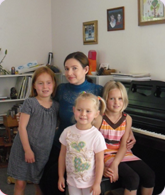The Effect of Sound




-- by Katharine Le Mee
The sense of hearing connects with the heart, and music and sound touch us most directly.
It is often said that we live in a visual culture. The fact remains that we also live in a strongly sonic atmosphere. We lose awareness of this background of sound. Nevertheless, we are continually subjected to its humming coming from electronic devices: computers, lights, amplifiers, etc. In addition, we hear all sorts of loud noises, sirens, airplanes, motors, not to mention boom boxes and music blasting from car windows. The American Speech and Hearing Association has estimated that 40,000,000 Americans live, work, or play around music that is dangerously loud. It is well documented that significant loss of hearing results when music is played too loud or too close to the ear. What we listen to matters. This is becoming more and more obvious.
Indeed, sound literally matters. It has the power to give shape to materials. A number of experiments have been done illustrating the effect of sound on inert matter. Substances such as iron filings, drops of water, soap bubbles, and lycopodium powder (spores of club moss) were placed on a diaphragm and subjected to a variety of sounds. As the sound changed, the result was a series of flowing, changing patterns of great beauty and complexity (Cymatics - the science of the way the properties of a medium change under the influence of vibration).
The effect of sound on living organisms is also well documented. Several studies show that trees increase their yield under the influence of music. In response to the music played, some plants grew toward or away from the speakers. With certain music some plants even withered and died.
What about humans? Do you think they might be more sensitive than plants?
The sense of hearing connects with the heart, and music and sound touch us most directly.
We do not resonate so deeply with the visual as with the auditory. This may be explained by the fact that our visual apparatus has a frequency range of slightly less than one octave, from infrared to ultraviolet, whereas our auditory system has a range of about eight octaves, approximately 60 to 16,000 hertz, or number of vibrations per second. We are sensitive to sound frequencies as pitch and to light frequency as color. The frequencies of the visual field are much higher than those of the auditory field, and as is well known, the higher the frequencies, the lesser the penetration of a given material. For instance, a piece of cardboard shields us easily from the light, but it takes a thick wall to block out sound, and the lower the pitch, the deeper the penetration. We are very sensitive to sound, not just through the ear, but also through our whole skin, and all our organs are affected by it.
The Energy of Sound
The music leaves its imprint in the appearance of its habitual listeners, to the extent that the effect is noticeable.
There is a story about Benedictine monastery in France in the early 1960s. At one point, due to the administration's decision, singing chants has been eliminated. As a result of it, monks became extremely fatigued. On top of it, their hearing was not as good as it should have been. When the daily chanting was brought back into the life of the monastery, they experienced an extraordinary improvement. What happened? A vital role is played by the ear in stimulating the brain's activity; in particular, it serves to charge the cerebral cortex with electrical potential. It is clear that a person with poor hearing is unable to effectively receive the charge of energy being provided by the ear. A well-tuned ear is able to stimulate the brain - but there is more to the story.
Modern research identifies two kinds of sounds, known as "discharge" sounds, which tire and fatigue the listener, and "charge" sounds, which give energy and health and which have the power to re-awaken the hearing and recharge the mind and body with energy. Charge sounds are rich in high frequencies, whereas discharge sounds are of low frequency. Putting an oscilloscope to the sounds of Gregorian Chant reveals that it contains all the frequencies of the voice spectrum, roughly 70 to 9,000 hertz. The monks sing in the medium range (baritone), but due to the unity and resonance of the sounds, their voices produce rich overtones of higher frequency in the range of 2,000 to 4,000 hertz that provide the charge to the brain. When the monks were not chanting, they were missing their daily dose of energy. These energies are very small in measurable terms. The fact is that it is not their energetic content that is important, but the information they carry. The way the monks receive energy through the sound is that it acts partly as a signal, which through the complex organization of the body and its energy fields, serves to reorganize the energy distribution within the body.
The music leaves its imprint in the appearance of its habitual listeners, to the extent that the effect is noticeable. The reason for this imprinting is that although we have five senses, five groups of organs through which we are in the contact with external reality, we relate to this reality in three ways: intellectually, emotionally, and actively, which constitute the bases for the formation of the personality being oriented along three great currents of psychic activity: intellectual, emotional and motor. Each of these is associated in a psychosomatic relation with a body location where it appears to evoke a resonance. These functions are located near head, heart, and guts. The music we hear is primarily apprehended by one center, emotional, intellectual, or active. Repeatedly acting on that center, it imparts its quality to our personality. Some rock and roll music that makes the pelvis gyrate hardly moves above the belt. Love and devotion, which obviously speak to the emotional center, are strongly evoked by the chants themselves. Baroque music - by Bach, Handel, Vivaldi, etc. - has a strong intellectual component and is related to the head, although the rhythm affects our active principle and the timbre and sonority, our emotions.
It may be interesting to note that language, spoken or sung, is formed of sounds. These sounds, in turn, resonate in the cavities of the body, in specific locations. Experimenting with the vowels U, O, A, E, and I, it is easy to verify that U resonates at the base of the spine; O - in the belly, A - in the chest or heart, E - in the throat, I - in the middle of the forehead; so that U and O are connected with the active principle, A - with the emotional, I - with the intellectual, and E participates in both intellectual and emotional. Thus, these vowels have the power to tune these principles and the organs connected with them. The resonance created in the bodies of the singers by the chanting of these vowels creates overtones high in frequency, which have an awakening effect. These are the charged sounds spoken of earlier.
